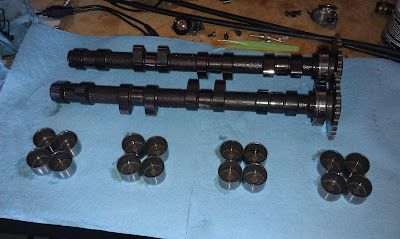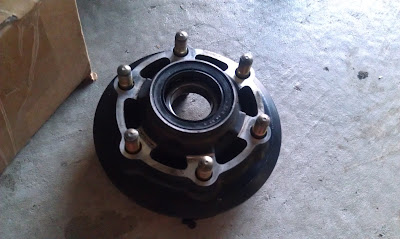 |
| AAAAaaawwwwwww yeeaaaah! |
Over the next few weeks I'm going to derive (build up) a carburetor from extremely simple beginnings. Hopefully this will not only show how various pieces work, but why they are neccessary in the first place.
Let's start with why carburetors (or indeed fuel injectors) are neccesary at all. Fuel itself is not extremely volatile and won't explode the way your engine needs it to without a good amount of air mixed into it. So the whole point of the carburetor, is to mix air and fuel in such a way that your motor can burn it up easily.
During the intake stroke of an engine, the downward motion of the piston creates a vacuum in the combustion chamber which in turn sucks air into the combustion chamber through the motor's intake port.
 |
| The downard motion of the piston creates a vacuum in the combustion chamber |
Of course your carburetors are mounted at the mouth of the intake port and therefore, air gets sucked through your carburetors as well.
As air moves through your carburetors, it passes the Venturi, a point where the diameter of the carburetor is reduced. When a volume of air moves through a restricted space, it naturally speeds up. This is called the Venturi Effect. Consequently, an increase in the speed of air results in a decrease its pressure. This is called the Bernoulli Principle. I'm not making this stuff up, I promise. Google it!
 |
| Slow moving air on the right is turned into fast moving air on the left by the venturi |
Now lets put a bowl of fuel under the venturi and lets say this bowl has atmospheric pressure (which would be higher pressure than the air passing through the venturi).
 |
| Imagine low pressure air in the carb throat and high pressure air in the fuel bowl |
If we were to connect the fuel bowl to the venturi, nature will attempt to balance out the negative air pressure in the venturi by sucking up air and fuel from the atmospherically pressurized fuel bowl. The fuel sprays out of the fuel bowl as a fine vapor and is carried into the engine by the air moving through the carburetor. The process creating this fuel vapor is called Atomization.
 |
| Fuel is sucked into the venturi as nature attempts to balance the low pressure air in the venturi with the atmospheric pressure air in the fuel bowl |
Proper atomization, that is, a proper mixture ratio of fuel to air, is the ultimate goal of tuning carburetors (a topic that will be covered later, maybe). To limit the amount of fuel that is atomized, the main passage that leads to the venturi (also called a Main Circuit) can be restricted with a Main Jet. A larger main jet opening will result in a Rich mixture of fuel and air, while a smaller main jet opening will will Lean out the mixture of fuel and air.
 |
| Main fuel circuit restricted with a mainjet |
While a carburetor like this might work in theory it isn't really practical. We can make it much more useful with the addition of a Throttle Plate A.K.A Butterfly Valve. The throttle plate rotates about a pivot located inside the carburetor allowing a rider or driver to modulate the amount of air that is pulled through the carburetors.
A fully open throttle plate allows the maximum amount of air and fuel to flow into the engine, almost as if the throttle plate wasn't there at all (almost).
 |
| A fully open throttle valve will allow maxium air and fuel flow into the engine |
A fully closed throttle plate on the other hand will (almost) completely cut off the vacuum created by the cylinders, preventing air from being drawn into the carburetor at all. Consequently, because no air is moving through the venturi so no fuel gets atomized :(
 |
| A closed throttle blocks air from passing over the main fuel circuit |
So this presents us with a problem. When we let go of the throttle, we don't want air and fuel to be cut form the engine completely because the engine will die! One solution to this problem is to introduce an Idle Circuit.
The idle circuit operates on the same principle as the main circuit. However, since the opening is located 'behind' the throttle plate the vacuum created by the engine will suck enough fuel and air to prevent the engine from dying even when the throttle plate is closed :)
 |
| The idle circuit allows fuel to be fed into the engine even with the throttle plate closed |
Like the main circuit, the atomization of fuel through the idle circuit can also be tuned with an Idle Jet A.K.A. Pilot Jet. A larger idle jet will richen the mixture of air and fuel, and a smaller idle jet will lean out the mixture of air and fuel.
 |
| Like the main circuit, the idle circuit can also be tuned with a restrictor |
With the throttle open, both the main and idle circuits work to feed fuel into the engine.
 |
| With the throttle open, both the main and idle circuits work to feed fuel into the engine |
Hopefully no one's head has exploded yet. Stay tuned for part 2.








































